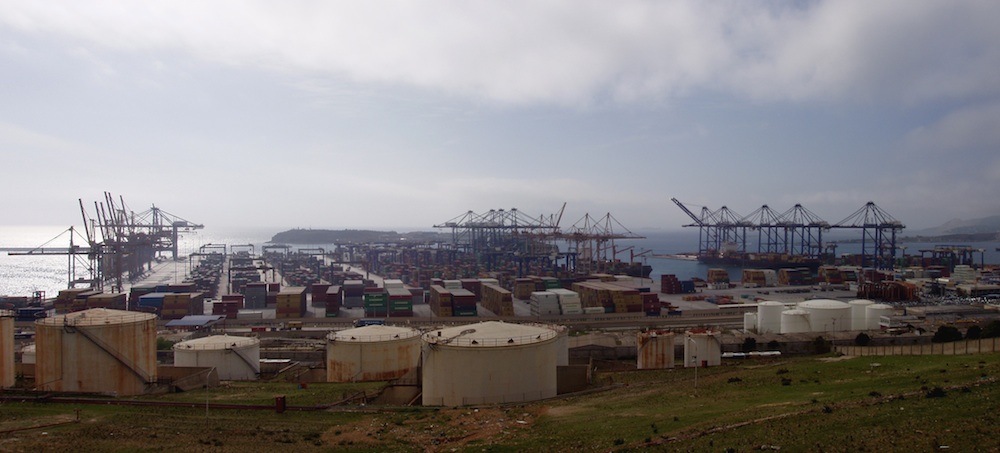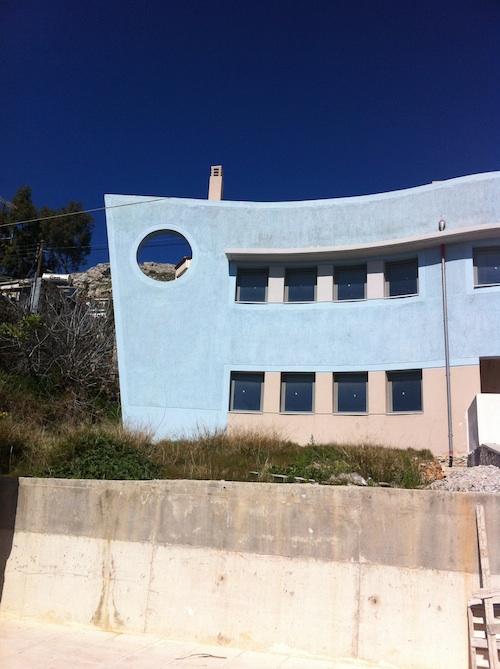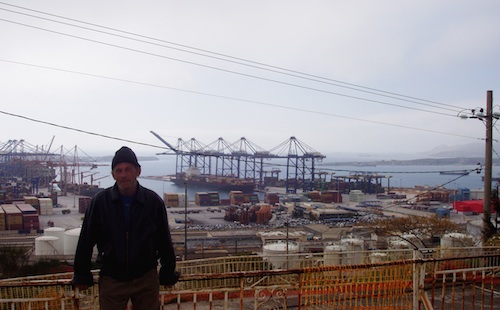Pavlos Hatzopoulos and Nelli Kambouri
Above the Piraeus container terminals stands a place, which seems out of joint. This area, part of the municipality of Perama, expands over the steep hill, which rises above the peripheral road of the port of Piraeus.
The area began to be populated around the 1970s, when its first settlers moved here to encroach and inhabit mostly empty land. The first residents chose these hills because they were empty, they offered a nice view and a relatively easy access to the sea. Some of them remember that they could swim in the sea when they first arrived. In subsequent decades, the port expanded and there is no longer any access to the seafront. In spite of the expansion of the port, new inhabitants kept coming to the area buying and building on encroached land for very low prices. One man told us that when he first arrived here in the 1980s, the price for the land where he built his home “was equal to one month’s salary”. Although some of the owners have been able to legalize their property in subsequent amnesties, most buildings do not meet official urban planning standards: they still lack a permit, they cannot be registered in the cadastre, there are is lack of land ownership titles, but the residents are still required to pay the new property tax levied via electricity bills.
Buildings have been designed to face the seafront. Most house facades and balconies offer a view of the open sea (back in the 1970s), the container terminals (nowadays). The only cafe of the area has also a privileged view downhill – gathered there, local residents gaze at the panoramic view of the operations in the optimized logistical space of the terminals. The loading and offloading of container ships, the movements of containers via RMGs, quay cranes, trucks, straddle carriers can be observed in a cinematic extreme long-shot. Residents in the cafe refer to this vista with ironic pride: “we maybe poor in terms of wealth, but wealthy in terms of the view”. One of their neighbors contrasts the openness of the landscape to the sense of imprisonment one feels in working class neighborhoods of central Athens and Piraeus. “I would not like to look at the dirty underwear of my neighbor. I prefer this. In winter we close the windows and then we do not listen anymore to the noise. The summer is more difficult”.

There is a voyeuristic intimacy between the two spaces. Located at a vantage point, the residents’ gaze is attracted by the infrastructural spectacle of the Piers. Talking about the five Super-Post Panamax cranes brought to Piraeus by Cosco-PCT in spring 2013, the customers of the cafe mention the “large Chinese boats that brought the cranes. They were all in one piece. And they installed them there. And then they built the other pier and now they will develop further the port”. Their gaze cannot, however, but remain fixed and aloof at an elevated distance. The area is in all other respects disjointed from the terminal operations, even in terms of living labour. The area has been hit severely by the economic crisis. There is poverty and long-term unemployment especially amongst the men. Until the mid-2000s, the male residents mostly worked in the Perama ship-repairing zone (located further West down the coastline), which has been severely hit by the crisis, in construction and in other industries, which still boomed in Perama and the surrounding areas until then. For residents, the spatial object of their gaze involves a type of living labour from which they feel totally alienated. No one from the area has ever worked in the container piers. Workers hired by the Piraeus Port Authority (OLP) are referred to by the locals as “privileged”, while Cosco-PCT, according to them, recruits mostly people who have university degrees and specialization: “we are not the people that they would hire”. For residents of the area, those who work in the container terminals live in the more affluent parts of Piraeus and are able to afford a different standard of living, legal housing in areas with proper infrastructures.
Dormant infrastructures
All the houses in the area were built without permits [αυθαίρετα]. This ambiguous legal status is instantly visible in their architecture: composed of DIY constructions, heterogeneous materials, with a lot of tin, brick and aluminum painted over. The non-legal status of the built environment of the area is also reflected in the state of the local infrastructures, developed and maintained by the municipality of Perama or the central Greek state. The space is packed with infrastructures that do not perform their intended functions: roads that are only partially asphalted or cemented, that end up in private backyards or derelict walls, and that do not hinge with the road network of the wider municipality; public lighting columns that emit no light; aging and new sewage pipes where no sewage flows. Some infrastructures remain in perpetual suspension: the church of the area has only been partly built and appears derelict. Instead of the usual Christian-Orthodox style dome, the church is topped by a bunch of steel bars that pop out of a flat unfinished cement roof. Its completion is in suspension as it depends on the financial contributions of the residents to the local parish, which are currently non-existent. One of the few modern -almost luxury- buildings in the area is designed to become a day care center and kindergarten. The EU funded day care center seems to be under construction for the past five years and, yet, it has never operated till now, although the building seems to be nearly finished. An extended makeshift electricity cable connects the building to the electricity column servicing the church, effectively stealing electricity for lighting up the construction work when it will resume. The incomplete and disjointed roads prevent public buses from entering the area, while garbage is not collected regularly if ever. As one resident, jokingly said, “If you take something out of your pocket -anything- and just leave it outside in this street today and then come back, here, in five years, it will still be there…No one collects anything here”.



Yet, the use of the areas’ infrastructures follows a certain logic, even certain logistical calculations. In front of the derelict church, the only extensive, flat-surfaced public space in the area, people in need line up each day for free meals. The free meals are provided by the Greek navy which operates a training base in a neighboring area. The meals seems to composed of leftovers from the food cooked for the conscripts. The food comes in a military truck, which has the capacity to navigate the roads of the area. Its time of arrival seems to be uncertain. One can wait for hours for the food to arrive, as we were told by people waiting in front of the church. A soon as the food arrives, however, its distribution is completed rapidly. The sailors move the large plastic boxes containing the food to a small side room of the church, the receivers enter this room with empty and exit with filled plastic bags and then head to their homes or shelters. The place empties in the space of a few minutes. The “just-in-time” delivery of the logistical organisation of the container terminal can be juxtaposed to the “in suspended time” logistical operations in Perama.


Recently -as we were told- a poster was put up in the area informing inhabitants that Cosco had bought the land occupied by an abandoned oil refinery that stands on the base of the hill, just above the port peripheral road (a land the residents refer to as “the boilers”). Discussions were held at a local council meeting for organising against this land acquisition, especially as this space has been designated by the Perama municipality in the past as that of a future playground, or a park, or a shopping centre.
The boilers are rumored to have been sought by Cosco-PCT for the development of a container park. Containers “will one day climb up and take over everything that you see around you” is the nightmare scenario fantasized by one resident. This articulation should be taken, however, as an imagining of an encounter (even this resident uttered it in comic disbelief). An imagining of an encounter between Cosco and the poor residents, which can potentially produce the area as a contested space. An encounter that can mobilize the residents and ignite struggle, that can produce the residents’ land as something which can be at stake between the global poor and global capital, an encounter that can register the potential struggle of the local inhabitants in the global circulation of capital.
This encounter remains, however, in suspension. The logistical operations of the port do not currently hinge with the messiness of this area of Perama. The Piraeus container terminal port is expanding in capacity and in business in disconnection from Perama; Piraeus’ development, according at least to the latest hype, into a transhipment hub, into China’s gateway Europe is in completely disjointed to the production of space in Perama under conditions of economic crisis. What lies above the Piraeus container terminals, is a space out of joint, a space unmapped by the logistical city.

